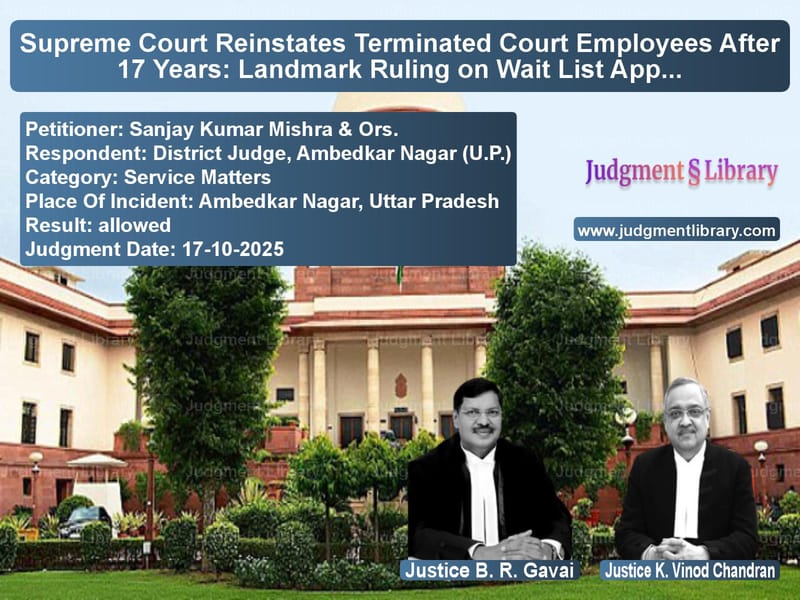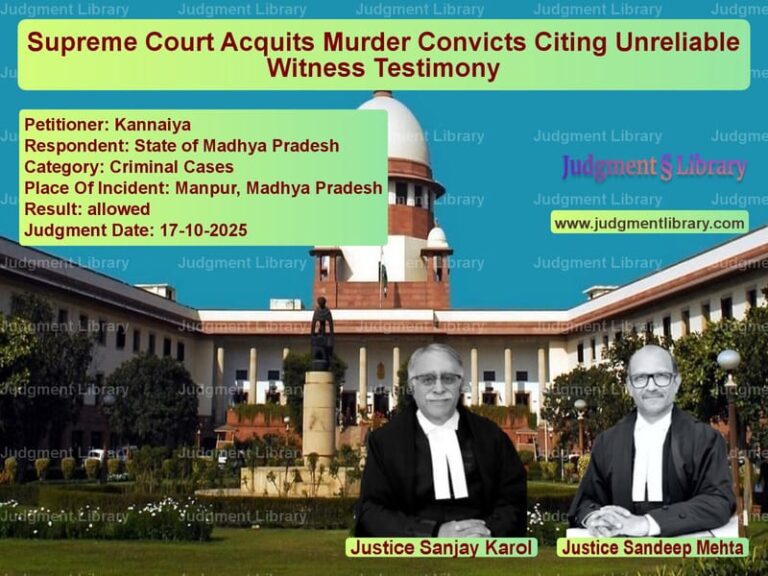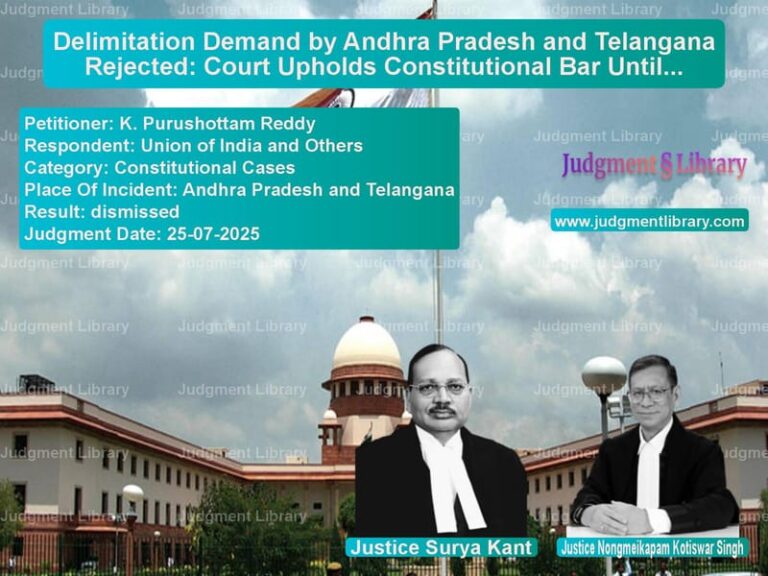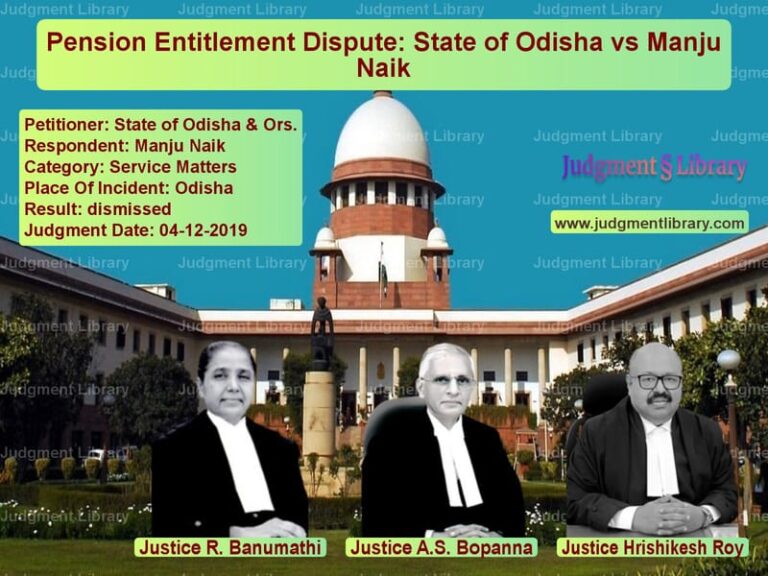Supreme Court Reinstates Terminated Court Employees After 17 Years: Landmark Ruling on Wait List Appointments
In a remarkable case that highlights the human cost of bureaucratic delays and legal technicalities, the Supreme Court has delivered justice to four court employees who were terminated from their jobs in 2008 and have been fighting for their rights for nearly two decades. The case involved Sanjay Kumar Mishra and three others who were appointed as Class IV employees in the District Judgeship of Ambedkar Nagar, Uttar Pradesh, only to be removed from service eight years later under controversial circumstances.
The heart of the matter dates back to the year 2000 when the District Judge of Ambedkar Nagar advertised twelve Class IV vacancies with a crucial rider that ‘the number of posts may be increased or decreased.’ Based on this advertisement, a selection process was conducted, and a wait list was prepared. The appellants were appointed between February and July 2001 and served continuously for eight years, with two of them even receiving temporary promotions in the Ministerial Cadre. However, in 2008, their world came crashing down when they received termination notices on the ground that their appointments were made in excess of the originally advertised vacancies.
The Legal Battle Begins
The terminated employees approached the courts, but both the learned Single Judge and the Division Bench of the Allahabad High Court found the termination to be justified. The courts below held that since the appointments were made beyond the number of vacancies advertised, the termination was legally valid. This left the appellants with no option but to approach the Supreme Court, carrying the burden of seventeen years without employment.
Before the Supreme Court, Sh. M.C. Dhingra, learned Senior Counsel appearing for the appellants, made a compelling argument. He submitted that ‘the vacancies advertised were twelve, but with a rider that it could increase or decrease.’ He relied heavily on the precedent set in Naseem Ahmad and Others v. State of Uttar Pradesh and Another, where Rule 12 was interpreted as permitting appointment to vacancies arising in excess of those advertised, provided it was done within a reasonable period.
The appellants’ counsel argued that ‘this Court according to the appellants found that appointments could be made in excess of vacancies that were advertised, which vacancies arose in the same recruitment year or the immediately succeeding year.’ This legal principle, they contended, directly applied to their case.
The State’s Counter-Arguments
Sh. Yashvardhan, learned counsel appearing for the respondent, however, took a different position. He took the Court to the judgment to assert that ‘as on the date of the advertisement there were only twelve vacancies and any further appointments made cannot be justified.’ The State’s position was that the appointments made beyond the originally advertised twelve vacancies were invalid from the beginning.
The Government Advocate specifically drew the Court’s attention to paragraph 14 of the impugned judgment, which referred to the counter affidavit filed by the State. The State had asserted before Court that ‘as on 18.10.2000, the date of advertisement, there were only twelve posts, and the subsequent advertisement was made on 06.06.2008 and later on 14.09.2015; which subsequent advertisements 29 and 2 vacancies were notified respectively.’
The Supreme Court’s Analysis
The Supreme Court conducted a thorough examination of the legal principles and factual matrix. The Court found the situation almost identical to the Naseem Ahmad case and held that Rule 12 was squarely applicable. The Court made several crucial observations that formed the basis of their decision.
The Court noted that ‘the advertisement specifically indicated that there could be an increase or decrease of vacancies, which as on the date of advertisement was also indicated as twelve posts. The said recital in the advertisement would clearly indicate that the Appointing Authority intended that a wait list be maintained so as to fill up the vacancies arising in excess of those notified, which was permissible as per the rules.’
This interpretation was consistent with the Court’s earlier ruling in Naseem Ahmad, where the expression ‘reasonable dimension’ used in Rule 12 was interpreted in paragraph 23 as follows: ‘The expression “reasonable dimension” used in Rule 12 of the aforesaid Rules signifies that the wait list should be a moderate one containing that number of candidates which is adequate to meet the vacancies which might be available within a reasonable period in the year of recruitment or the year succeeding thereto and this list should be in reasonable proportion to the notified vacancies. To be more precise, this waiting list should broadly be correlated to the number of vacancies either available in the year of recruitment or likely to become available in the succeeding year and the proportion qua the existing and anticipated vacancies. It is only in order to obviate the possibility of the waiting list becoming vitiated on account of the vice of arbitrariness or illegal discrimination that the provision contains the Rule which specifically provides for maintaining a waiting list of a reasonable dimension.’
The Court further observed that ‘as has been pointed out from the counter affidavit after the advertisement of 2000, the next advertisement was only in 2008 and then in 2015. Definitely vacancies arose within the said period, and this is the reason why the appellants were appointed on various dates subsequent to the appointment to the twelve vacancies advertised.’
Read also: https://judgmentlibrary.com/supreme-court-resolves-telangana-judicial-service-recruitment-dispute/
In a clear rebuke to the lower courts’ reasoning, the Supreme Court stated: ‘We are definite that the very same situation arose in Naseem Ahmed and the learned Single Judge as also the Division Bench erred in not accepting the said contention, especially having ignored the clear recital of the notification that the vacancies could be increased or decreased from twelve, as notified.’
The Court’s Final Ruling and Relief
The Court concluded unequivocally: ‘We cannot but find the termination to be unjustified.’ However, the Court also had to grapple with the practical reality that the appellants had been out of employment for almost 17 years and some had reached or were approaching retirement age.
The Court noted that ‘the fact remains that the appellants have been out of employment for almost 17 years. We also see from the select list that the date of birth of 2nd and 4th appellants indicate the said appellants having passed the age of 60, while the others have little more time to superannuate, if the age of superannuation is 60.’
In the peculiar circumstances of the case, especially considering that ‘the appellants have not taken any efforts to pinpoint the substantive vacancies to which they were appointed and the appointment itself having been made temporarily,’ the Court issued specific directions:
The appellants if not having completed the age of superannuation shall be accommodated in the existing vacancies of Class IV in the District Judgeship of Ambedkar Nagar. If there are no vacancies existing, they shall be appointed in a supernumerary post, which shall be adjusted against the future vacancies or shall seize on their retirement, whichever occurs earlier.
If any of the appellants have crossed the age of superannuation, they shall be entitled to minimum pension dehors the fact that they have completed only 8 years in employment and not entitled to an appointment as of now.
Those appellants who are appointed shall be continued without any seniority but reckoning the period already spent in service also for determining pensionable service and in any event shall be granted pension at the minimum.
The appellants shall not be entitled to treat the intervening period of 17 years in which they have not worked, for any purpose, neither as notional service nor even for computing pensionable service.
The above directions shall apply only to the four appellants herein.
The Court specifically clarified that ‘the directions issued are in the peculiar circumstances of this case and shall not be a precedent,’ indicating that this was a unique solution tailored to address the specific injustice suffered by these appellants.
Broader Implications
This judgment serves as an important reminder about the purpose and proper interpretation of wait lists in government recruitment. The Court reinforced the principle that when advertisements specifically mention that vacancies may increase or decrease, and when rules provide for maintaining wait lists of ‘reasonable dimensions,’ appointments from such wait lists to fill additional vacancies arising within a reasonable time frame are perfectly valid.
The case also highlights the human dimension of legal disputes – four individuals lost seventeen years of their working lives due to what the Supreme Court found to be an erroneous interpretation of recruitment rules. While the Court could not restore those lost years, it provided meaningful relief that acknowledged their unjust termination and ensured they receive some financial security in their retirement years.
This judgment underscores the judiciary’s role in protecting the rights of employees against arbitrary termination and ensuring that technicalities don’t override substantial justice. It sends a clear message to recruiting authorities about the proper use and interpretation of wait lists, while also demonstrating the Court’s ability to craft practical solutions that address both legal principles and human realities.
Petitioner Name: Sanjay Kumar Mishra & Ors..Respondent Name: District Judge, Ambedkar Nagar (U.P.).Judgment By: Justice B. R. Gavai, Justice K. Vinod Chandran.Place Of Incident: Ambedkar Nagar, Uttar Pradesh.Judgment Date: 17-10-2025.Result: allowed.
Don’t miss out on the full details! Download the complete judgment in PDF format below and gain valuable insights instantly!
Download Judgment: sanjay-kumar-mishra-vs-district-judge,-ambe-supreme-court-of-india-judgment-dated-17-10-2025.pdf
Directly Download Judgment: Directly download this Judgment
See all petitions in Employment Disputes
See all petitions in Termination Cases
See all petitions in Public Sector Employees
See all petitions in Recruitment Policies
See all petitions in Pension and Gratuity
See all petitions in Judgment by B R Gavai
See all petitions in Judgment by K. Vinod Chandran
See all petitions in allowed
See all petitions in supreme court of India judgments October 2025
See all petitions in 2025 judgments
See all posts in Service Matters Category
See all allowed petitions in Service Matters Category
See all Dismissed petitions in Service Matters Category
See all partially allowed petitions in Service Matters Category







